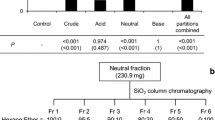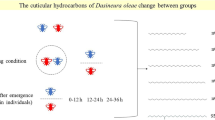Abstract
Callosobruchus seed beetles (Coleoptera: Chrysomelidae: Bruchinae) are pests of stored legumes in tropical and subtropical regions. The cuticular surfaces of female Callosobruchus seed beetles contain a contact sex pheromone, which elicits copulatory behavior in congeneric males. Asymmetric cross-copulatory behavior was observed between C. maculatus and C. rhodesianus despite considerable differences in the structures of their contact sex pheromones. C. maculatus uses dicarboxylic acid, whereas C. rhodesianus uses two ketone compounds in conjunction with similar synergistic cuticular hydrocarbon blends in both cases. Male C. maculatus exhibited copulatory behavior with females of both C. maculatus and C. rhodesianus, but male C. rhodesianus mated only with congeneric females. To establish the reasons for the asymmetric cross-copulatory behavior of C. maculatus, we tried to identify the heterospecific mate-eliciting compounds in the cuticles collected from virgin C. rhodesianus females. The compounds were fractionated using acid-base partitioning and chromatography techniques and then assayed for their ability to elicit male copulatory activity. Gas chromatography–mass spectrometry (GC–MS) analysis of the active acidic fraction revealed the presence of three dicarboxylic acids: 2-methylsuberic acid (2-methyloctanedioic acid) (1), 3-methylsuberic acid (3-methyloctanedioic acid) (2), and nonanedioic acid (3). The synergistic effect was compared using synthetic standards and natural hydrocarbons. When the compounds were combined with the natural hydrocarbons, compounds 1 and 2 elicited significant copulatory activity in male C. maculatus. In contrast, relative to the effect of natural hydrocarbons alone, compound 3 did not exhibit significant copulatory activity when combined with natural hydrocarbons. The results demonstrated that the asymmetric cross-copulatory behavior of C. maculatus is induced by the presence of contact sex pheromone analogs on the cuticular surface of female C. rhodesianus. In combination with previous reports, although a saltational evolution was hypothesized for the contact sex pheromones of C. rhodesianus, this species continues to produce dicarboxylic acids functioning as pheromones that are structurally similar to those secreted by closely related species.




Similar content being viewed by others
References
Allison JD, Roff DA, Cardé RT (2008) Genetic independence of female signal form and male receiver design in the almond moth, Cadra cautella. J Evol Biol 21:1666–1672. doi:10.1111/j.1420-9101.2008.01595.x
Baker CT (2002) Mechanism for saltational shifts in pheromone communication systems. Proc Natl Acad Sci USA 99:13368–13370. doi:10.1073/pnas.222539799
Borowiec I (1987) The genera of seed-beetles (Coleoptera: Bruchidae). Pol Pis Entomol 57: 3–207
Bostedor RG, Karkas JD, Arison BH, Bansal VS, Vaidya S, Germershausen JI, Kurtz MM, Bergstrom JD (1997) Farnesol-derived dicarboxylic acids in the urine of animals treated with zaragozic acid A or with farnesol. J Biol Chem 272:9197–9203. doi:10.1074/jbc.272.14.9197
Droney DC, Musto CJ, Mancuso K, Roelofs WL, Linn CE Jr (2012) The response to selection for broad male response to female sex pheromone and its implications for divergence in close-range mating behavior in the European corn borer moth, Ostrinia nubilalis. J Chem Ecol 38:1504–1512. doi:10.1007/s10886-012-0208-5
Eliyahu D, Mori K, Takikawa H, Leal WS, Schal C (2004) Behavioral activity of stereoisomers and a new component of the contact sex pheromone of female German cockroach, Blattella germanica. J Chem Ecol 30:1839–1848. doi:10.1023/B:JOEC.0000042405.05895.3a
Eliyahu D, Nojima S, Mori K, Schal C (2008a) New contact sex pheromone components of the German cockroach, Blattella germanica, predicted from the proposed biosynthetic pathway. J Chem Ecol 34:229–237. doi:10.1007/s10886-007-9409-8
Eliyahu D, Nojima S, Capracotta SS, Comins DL, Schal C (2008b) Identification of cuticular lipids eliciting interspecific courtship in the German cockroach, Blattella germanica. Naturwissenschaften 95:403–412. doi:10.1007/s00114-007-0339-7
Gemeno C, Schal C (2004) Sex pheromones of cockroaches. In: Cardé RT, Millar JG (eds) Advances in insect chemical ecology. Cambridge University Press, Cambridge, pp 179–247
Lassance JM, Groot TA, Liénard AM, Antony B, Borgwardt C, Andersson F, Hedenström F, Heckel GD, Löfstedt C (2010) Allelic variation in a fatty-acyl reductase gene causes divergence in moth sex pheromones. Nature 466:486–489. doi:10.1038/nature09058
Niehuis O, Buellesbach J, Gibson DJ, Pothmann D, Hanner C, Mutti SN, Judson KA, Gadau J, Ruther J, Schmitt T (2013) Behavioural and genetic analyses of Nasonia shed light on the evolution of sex pheromones. Nature 494:345–348. doi:10.1038/nature11838
Nishida R, Fukami H (1983) Female sex pheromone of the German cockroach, Blattella germanica. Mem Coll Agric Kyoto Univ 122: 1–24
Nojima S, Shimomura K, Honda H, Yamamoto I, Ohsawa K (2007) Contact sex pheromone components of the cowpea weevil, Callosobruchus maculatus. J Chem Ecol 33:923–933. doi:10.1007/s10886-007-9266-5
Phelan PL (1992) Evolution of sex pheromones and the role of asymmetric tracking. In: Roitberg BD, Isman MB (eds) Insect chemical ecology: an evolutionary approach. Chapman and Hall, New York, pp 265–314
Phelan PL (1997) Genetic and phylogenetics in the evolution of sex pheromones. In: Cardé TR, Minks KA (eds) Insect pheromone research new directions. Chapman and Hall, New York, pp 563–579
Rees DP (1996) Coleoptera. In: Subramanyam B, Hagstrum DW (eds) Integrated management of insects in stored products. Marcel Dekker, New York, pp 1–40
Rees DP (2004) Beetles (order: Coleoptera). In: Rees DP (ed) Insects of stored products. CSIRO Publishing, Canberra, pp 11–120
Rice WR (1989) Analyzing tables of statistical tests. Evolution 43:223–225. doi:10.2307/2409177
Roelofs LW, Liu W, Hao G, Jiao H, Rooney PA, Linn EC Jr (2002) Evolution of moth sex pheromones via ancestral genes. Proc Natl Acad Sci USA 99:13621–13626. doi:10.1073/pnas.152445399
Schal C, Burns EL, Jurenka RA, Blomquist GJ (1990) A new component of the female sex pheromone of Blattella germanica (L.) (Dictyoptera: Blattellidae) and interaction with other pheromone components. J Chem Ecol 16:1997–2008. doi:10.1007/BF01020511
Shimomura K, Akasaka K, Yajima A, Mimura T, Yajima S, Ohsawa K (2010a) Contact sex pheromone components of the seed beetle, Callosobruchus analis (F.). J Chem Ecol 36:955–965. doi:10.1007/s10886-010-9841-z
Shimomura K, Mimura T, Ishikawa S, Yajima S, Ohsawa K (2010b) Variation in mate recognition specificities among four Callosobruchus seed beetles. Entomol Exp Appl 135:315–322. doi:10.1111/j.1570-7458.2010.00994.x
Shimomura K, Matsui S, Ohsawa K, Yajima S (2016) Saltational evolution of contact sex pheromone compounds of Callosobruchus rhodesianus (Pic). Chemoecology 26:15–23. doi:10.1007/s00049-015-0204-7
Shirangi RT, Dufour DH, Williams MT, Carroll BS (2009) Rapid evolution of sex pheromone-producing enzyme expression in Drosophila. PLoS Biol 7:e100168. doi:10.1371/journal.pbio.1000168
Smadja C, Butlin RK (2009) On the scent of speciation: the chemosensory system and its role in premating isolation. Heredity 102:77–97. doi:10.1038/hdy.2008.55
Stetter H, Klauke E (1953) Eine neue methode zur darstellung langkettiger carbonsäuren, IV. mitteil.: darstellung einiger verzweigter mono- und dicarbonsäuren. Chem Ber 86:513–518. doi:10.1002/cber.19530860413
Symonds MRE, Elgar MA (2008) The evolution of pheromone diversity. Trends Ecol Evol 23:220–228. doi:10.1016/j.tree.2007.11.009
Tanaka K, Ohsawa K, Honda H, Yamamoto I (1981) Copulation release pheromone, erectin, from the azuki bean weevil (Callosobruchus chinensis L.). J Pestic Sci 6:75–82. doi:10.1584/jpestics.6.75
Tuda M, Rönn J, Buranapanichpan S, Wasano N, Arnqvist G (2006) Evolutionary diversification of the bean beetle genus Callosobruchus (Coleoptera: Bruchidae): traits associated with storedproduct pest status. Mol Ecol 15:3541–3551. doi:10.1111/j.1365-294X.2006.03030.x
Wyatt TD (2003) Pheromones and animal behavior: communication by smell and taste. Cambridge University Press, Cambridge
Xue B, Rooney PA, Kajikawa M, Okada N, Roelofs LW (2007) Novel sex pheromone desaturases in the genomes of corn borers generated through gene duplication and retroposon fusion. Proc Natl Acad Sci USA 104:4467–4472. doi:10.1073/pnas.0700422104
Yajima A, Akasaka K, Nakai T, Maehara H, Nukada T, Ohrui H, Yabuta G (2006) Direct determination of the stereoisomer constitution by 2D-HPLC and stereochemistry-pheromone activity relationship of the copulation release pheromone of the cowpea weevil, Callosobruchus maculatus. Tetrahedron 62:4590–4596. doi:10.1016/j.tet.2006.02.059
Author information
Authors and Affiliations
Corresponding author
Additional information
Communicated by Michael Heethoff.
Rights and permissions
About this article
Cite this article
Shimomura, K., Matsui, S., Ohsawa, K. et al. Identification of cuticular compounds collected from Callosobruchus rhodesianus (Pic) eliciting heterospecific mating behavior with male Callosobruchus maculatus (F.). Chemoecology 27, 65–73 (2017). https://doi.org/10.1007/s00049-017-0231-7
Received:
Accepted:
Published:
Issue Date:
DOI: https://doi.org/10.1007/s00049-017-0231-7




